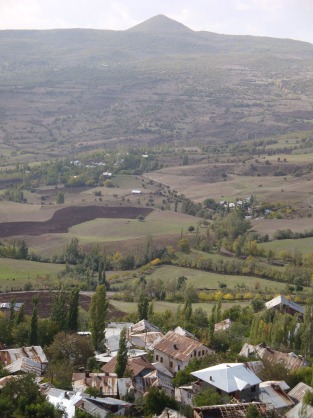“Alum Black Castle” Population: 10,700
Old name: Koloneia
Approaching the small town of Şebinkarahisar from Giresun on the Black Sea coast the road south from the Eğribel Pass (2260m) descends steeply into a beautiful valley which is at its most dramatic as you near the town. The epithet “şebin (alum)” that was added to the “karahisar (black castle)” part of the town’s name to distinguish it from Afyonkarahisar in the west was a nod of recognition to the alum, useful for textile dyeing, that was its main trading commodity.
As so often in this part of the world the ” black castle” fell victim to a terrible earthquake in 1939 and what you see here now is a fairly predictable town centre not unlike those all round the country. But the castle is a winner and the obvious starting point for your explorations.
It’s also worth heading for the rock-cut monastery at nearby Kayadibi to see some of the spectacular rock formations along the way. On the drive back you will get a superb view of the castle clinging to its rocky lookout post in all its glory. From this angle you might agree with the 17th-century traveller, Evliya Çelebi, who described it as looking like “a galleon without masts”, or with the Byzantine scholars, Anthony Bryer and David Winfield, who described it as looking “like an ark alone in the midst of a sea of flowers”.
Backstory
Inevitably the castle has been rebuilt time and again over the centuries, and it’s thought that it probably stands on the site of even earlier fortifications erected by the Pontic kings who ruled the area from their capital in Amasya.
What happened afterwards is not entirely clear but it seems that the Roman general Pompey established a colony of veterans here after defeating King Mithridates in 63 BC. His settlement was named Koloneia and the castle above it was called Mavrokastron, the Greek for “black castle”.
Almost as soon as the Selçuk Turks had defeated the Byzantines at Manzikert near Lake Van in 1071, the Saltukid emirs of Erzurum seized the town. There then followed four centuries during which a succession of different Turkic dynasties held sway here.
The Mengüçekids and Eretnids languish in the same sort of historical obscurity as the Goths and Visigoths who overran Europe after the fall of the Roman Empire but they were succeeded by the rather better known Akkoyunlu (White Sheep) and Karakoyunlu (Black Sheep) dynasties until finally in 1471 Sultan Mehmed II, still brimming with confidence after his capture of Constantinople (İstanbul) in 1453, defeated the Akkoyunlu leader, Uzun Hasan (Tall Hasan), at the battle of Otlukbeli and brought what was by then Şebinkarahisar into the Ottoman fold.
In 1915 the castle became the hiding place of the town’s Armenian inhabitants and was badly damaged by the effort to drive them out. Attempts to escape proved fruitless – the men were killed, the women and children driven out to fend for themselves. Then the earthquake brought down most of what remained of the castle’s sturdy walls.
Around town
As you head up to the castle from the Fatih Cami (1478, rebuilt in 1888) you will see by the roadside the shattered remnants of the 17th-century Taşhanlar (Stone Inns), the caravanserai paid for by the military leader, Taban Ahmet Ağa, where merchants and their animals would have been able to stay. Like the mosque, the caravanserai was brought down by the earthquake although the mosque has since been rebuilt.
A rough path winds most of the way up and the inner keep has been rebuilt. Otherwise it’s a wild and romantic place, the sort of place, in fact, where you’ll probably find yourself falling into conversation with a goatherd while pondering the vicissitudes of history.
The town centre harbours a few old Ottoman houses of passing interest and a small museum (closed Mondays) housed in a wooden building visited by Atatürk in the 1930s across the road from the celebratory İstiklal Çeşmesi (Independence Fountain).
Sleeping
There’s a much better choice of places to stay in Giresun.
Otel Hancılar Breath-taking view from the breakfast room windows and proximity to the ruins might make this a good choice for exploring the area. Tel: 0454-711 3540
Travel info
Dolmuşes to Şebinkarahisar leave Giresun from the dolmuş terminal on the waterfront opposite the Hotel Başar at 9am and 10am. Book a ticket back as soon as you arrive if you only want to make a day trip of it – the last return dolmuş is at 5pm.
Day trip destinations


